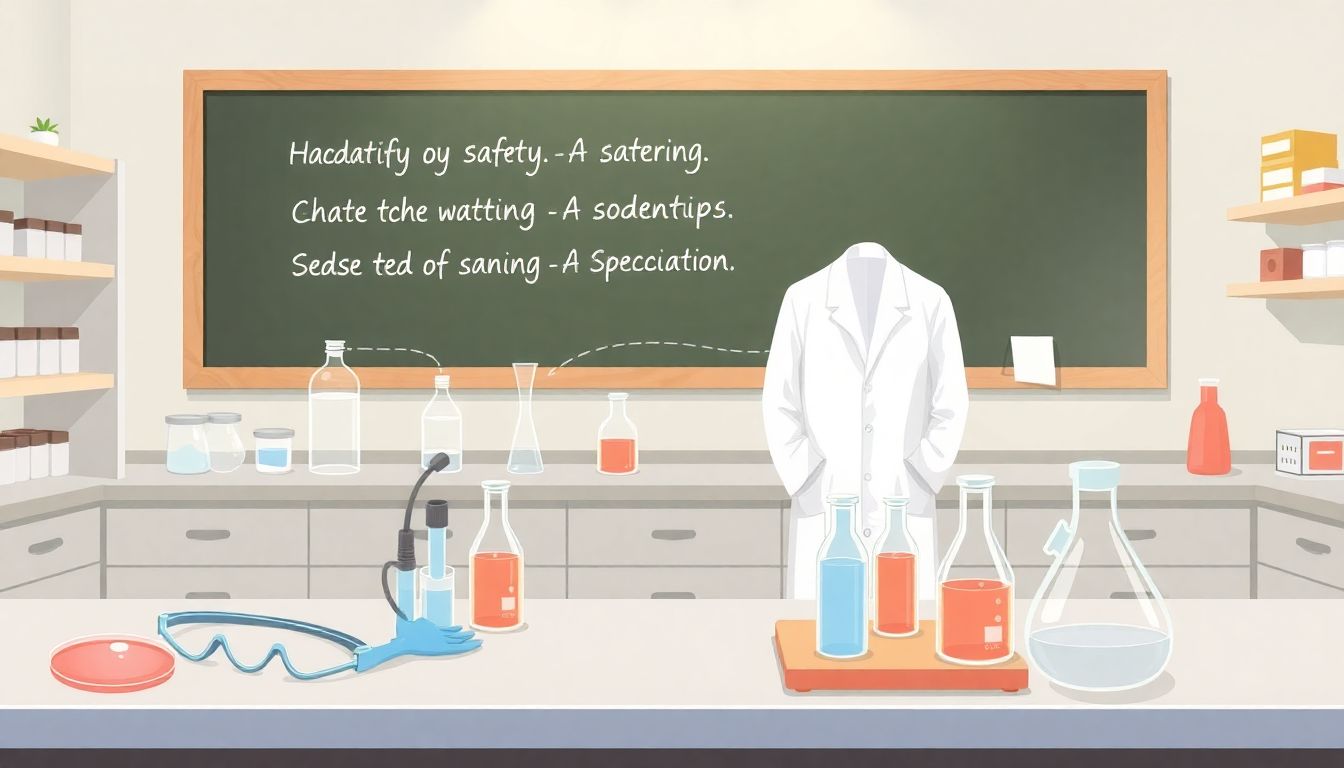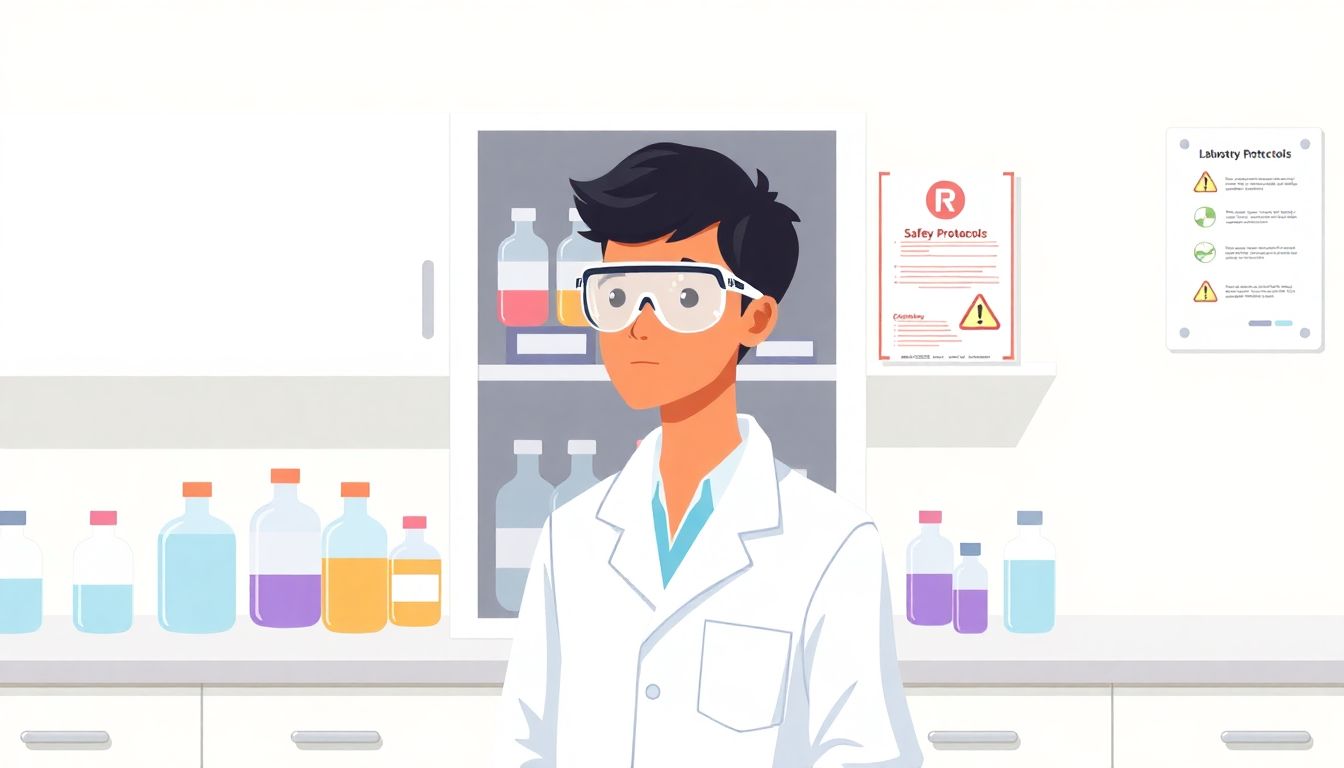Safety in chemistry labs is a big deal, and it’s easy to feel a bit overwhelmed by all the precautions you need to take. You might be wondering how to make sure you and your classmates are safe while still having fun with experiments. Trust me, you’re not alone in feeling that way!
But don’t worry! If you hang in there, I’ve got some great prompts that can help you master chemical safety simulations. These tips will not only help you understand the essential safety components but also make learning feel engaging and interactive.
From role-playing lab scenarios to creating checklists and avoiding common pitfalls, this guide has got it all. So, let’s dive in and discover how to keep safety at the forefront of our chemistry adventures!
Key Takeaways
- Safety in chemistry labs is crucial for preventing accidents and injuries.
- Use effective prompts to create simulations that enhance learning and engagement.
- Key safety components include hazard identification, PPE, and Material Safety Data Sheets.
- Real-life scenarios and role-playing can significantly improve understanding of safety protocols.
- Interactive learning methods like gamification and quizzes make safety training enjoyable.
- Regularly evaluate safety protocols to ensure continuous improvement in lab safety.
- Create checklists for safety measures before starting any lab work to enhance preparedness.

Effective ChatGPT Prompts for Chemistry Safety Simulations
Creating effective prompts for ChatGPT can enhance the learning experience for chemistry safety simulations.
Here’s a list of actionable prompts that you can use right away:
- “Generate a simulation of a chemical spill in a laboratory, including emergency response steps and required PPE.”
- “Create an interactive Q&A session about chemical hazards based on a specific laboratory setup.”
- “List best practices for handling corrosive substances in a chemistry lab.”
- “Simulate a conversation between lab partners discussing how to prevent accidents with flammable materials.”
- “Provide a step-by-step protocol for dealing with hazardous materials, including references to Material Safety Data Sheets.”
Understanding Chemical Safety: Key Components to Include
Chemical safety is crucial in the laboratory, as it helps prevent accidents and injuries.
Key components to include are:
- Chemical Hazard Identification: Know the hazards associated with each chemical you use.
- Personal Protective Equipment (PPE): Always use gloves, goggles, and lab coats suitable for the chemicals you’re handling.
- Material Safety Data Sheets (MSDS): Familiarize yourself with MSDS for safe handling procedures and first aid measures for chemicals.
- Risk Assessment in Chemistry: Evaluate the risks linked to specific activities or chemicals to take appropriate safety measures.
- Lab Safety Best Practices: Follow established protocols and make sure to maintain an organized workspace.
Real-Life Scenarios for Chemistry Safety Simulations
Learning from real-life scenarios can significantly improve understanding of chemistry safety.
Here are some essential situations to consider for simulations:
- Emergency Response in Labs: Create scenarios where students must respond to a chemical exposure incident.
- Chemical Spill Scenarios: Simulate a spill and require participants to carry out cleanup using best practices.
- Fire Safety in Chemistry Labs: Explore fire response protocols through interactive simulations involving flammable materials.
- Case Studies in Chemical Safety: Analyze past incidents to understand common mistakes and improve safety protocols.
- Real-World Lab Safety Incidents: Discuss how real accidents could have been avoided with better practices.
Interactive Prompts to Enhance Chemistry Safety Learning
Interactive learning can be a game-changer when it comes to teaching chemistry safety.
Here’s how to implement it:
- Gamification in Lab Safety: Design a chemistry safety trivia game to reinforce knowledge in a fun way.
- Role-Playing for Chemistry Safety: Create role-playing scenarios where students act out safety protocols for fun and practical learning.
- Interactive Quizzes for Safety Training: Develop quizzes that allow participants to apply what they’ve learned in real-time.
- Simulated Safety Drills: Conduct mock drills for emergency situations, engaging students in the response process.
- Hands-On Safety Training Methods: Provide practical training sessions where learners can practice using PPE and safety equipment.

Using ChatGPT to Role-Play Safety Situations in the Lab
Role-playing safety situations in a chemistry lab can be an effective way to reinforce safety protocols and prepare students for real-world scenarios.
To get the most out of ChatGPT for this purpose, consider the following prompts:
- “Simulate a lab discussion between two students about the proper steps to take during a chemical spill.”
- “Create a dialogue between a lab supervisor and a student who has questions about using PPE correctly.”
- “Generate a scenario where a lab incident occurs and require participants to discuss emergency evacuation procedures.”
- “Role-play a safety meeting where lab members debate the effectiveness of current safety protocols.”
- “Facilitate a situation where students must respond to a colleague’s unsafe lab practices in real time.”
Creating Checklists for Chemistry Safety through ChatGPT Prompts
Checklists are handy tools for ensuring all necessary safety measures are followed before beginning any lab work.
Here are some effective prompts you can use to create checklists with ChatGPT:
- “Generate a comprehensive checklist for preparing a chemistry lab for an experiment involving hazardous materials.”
- “Create a safety checklist for using volatile substances in the lab, including storage and disposal.”
- “List essential PPE items needed for conducting experiments with corrosive chemicals.”
- “Compile a pre-experiment safety checklist to ensure all safety equipment is functional and accessible.”
- “Draft a checklist for emergency procedures every student should know before starting lab work.”
Evaluating Chemistry Safety Protocols with ChatGPT
Regular evaluation of safety protocols is essential for ongoing safety improvement in any laboratory environment.
Use these prompts to assess and enhance your chemistry safety measures:
- “Evaluate the current lab safety protocol and suggest improvements based on recent incident reports.”
- “Generate a list of criteria for conducting a safety audit in a chemistry lab.”
- “Create a feedback form for evaluating the effectiveness of safety training sessions.”
- “Summarize key elements that should be included in a safety protocol review meeting.”
- “Discuss common vulnerabilities in existing lab safety measures and propose actionable solutions.”
Fun and Engaging Prompts to Teach Chemistry Safety
Making safety learning enjoyable can significantly enhance student engagement and retention of important information.
Here are some exciting prompts to incorporate into safety education:
- “Design a chemistry safety escape room challenge where students solve safety puzzles to ‘escape’ a hazardous situation.”
- “Create a ‘choose your own adventure’ story that explores various lab scenarios and safety responses.”
- “Develop a board game focused on lab safety decision-making where players navigate common lab hazards.”
- “Generate a fun quiz game format for lab safety rules that includes true/false, multiple-choice, and scenario-based questions.”
- “Compile a list of creative icebreaker activities that introduce chemistry safety concepts to new students.”

Common Mistakes in Chemistry Safety and How to Avoid Them
Understanding common mistakes in chemistry safety can prevent accidents and injuries in the lab.
Some prevalent errors include:
- Neglecting PPE: Students sometimes forget to wear proper personal protective equipment, increasing their risk of exposure.
- Improper Storage of Chemicals: Failing to store chemicals according to their classification can lead to dangerous reactions.
- Lack of Communication: Not discussing lab protocols or changes with colleagues can create unsafe environments.
- Assuming Safety Procedures are Obsolete: Assuming that old safety protocols are still effective without reevaluation can be catastrophic.
- Skipping Safety Drills: Ignoring scheduled safety drills may lead to confusion during real emergencies.
To help avoid these pitfalls, use the following prompts in ChatGPT:
- “List five common mistakes in chemistry labs and how to avoid them.”
- “Generate a safety improvement plan based on frequent lab errors.”
- “Discuss the importance of PPE in avoiding lab accidents.”
- “Create a checklist for ensuring proper chemical storage practices.”
- “Simulate a lab meeting to address safety concerns and common mistakes.”
Resources for Further Learning on Chemistry Safety
Enhancing your knowledge of chemistry safety is vital for anyone working in a lab environment.
Here are some excellent resources:
- Chemical Safety Textbooks: Pursue foundational knowledge in books specifically focused on laboratory safety.
- Online Safety Training Courses: Enroll in courses from reputable platforms that offer comprehensive safety training.
- Approved Safety Certifications: Obtain certifications recognized by safety organizations to show proficiency in lab safety.
- Reputable Safety Organizations: Follow organizations like the American Chemical Society or OSHA for updates on safety regulations and best practices.
- Educational Videos on Lab Safety: Watch video content that illustrates proper safety procedures and real-life examples of lab incidents.
To dig deeper using ChatGPT, try these prompts:
- “List top textbooks for chemical safety education.”
- “Provide links to reputable online training resources for lab safety.”
- “Summarize the latest guidelines from OSHA regarding laboratory safety.”
- “Identify key organizations that focus on improving chemical safety in educational settings.”
- “Curate a list of helpful videos for teaching chemistry safety.”
FAQs
Effective prompts for chemistry safety simulations include specific scenarios, safety protocols, hazard assessments, and role-playing situations. They should encourage critical thinking and problem-solving skills relevant to real-life lab situations.
You can use ChatGPT to generate comprehensive safety checklists by providing it with relevant safety protocols and lab tasks. This can ensure all necessary precautions are considered before conducting experiments.
Common mistakes in chemistry safety include neglecting PPE requirements, failing to read labels, and improper waste disposal. Awareness and adherence to established protocols can significantly reduce the risks involved in lab work.
